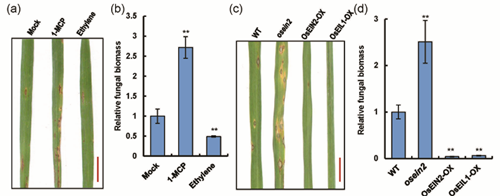The Plant Journal:中科院微生物所刘俊课题组发表水稻抗稻瘟病机制
2016年10月4日,国际植物学权威期刊《The plant Journal》在线发表了中国科学院微生物研究所刘俊研究组的一篇研究论文,研究首次证明在稻瘟菌侵染后,乙烯信号通过激活活性氧的产生和植保素的合成从而调控水稻的抗病性。刘俊课题组助理研究员杨超为论文第一作者,刘俊研究员为论文通讯作者。
由稻瘟菌(Magnaporthe oryzae)引起的稻瘟病是危害水稻最严重的真菌病害,每年给水稻生产带来巨大损失,严重发病的田块甚至绝产。在植物抗病机制研究过程中发现,多种植物激素在植物应对外界生物与非生物胁迫过程中发挥重要作用。其中,气体乙烯被认为是一类逆境激素而受到重视。以往有关乙烯对植物抗病性的研究主要集中在模式植物拟南芥上。但乙烯如何控制水稻对稻瘟菌的抗病机制仍然不甚清楚。有关乙烯信号转导途径以及乙烯信号组分在水稻抗病过程中所起的作用至今没有报道。
研究发现稻瘟菌侵染水稻后,会激活水稻体内的乙烯合成途径,并且抗病品种比感病品种积累了较高水平的乙烯。经乙烯处理后的水稻幼苗表现出对稻瘟菌的抗病性,而用乙烯信号抑制剂处理的幼苗则较为感病。利用已经鉴定的乙烯信号组分的突变体和过表达材料,发现乙烯信号传递的主调控因子OsEIN2突变后导致水稻对稻瘟病更加敏感,而过表达OsEIN2及其下游转录因子OsEIL1的水稻则表现出较强的稻瘟病抗性。这些结果表明水稻的乙烯信号正调控了水稻对稻瘟病的抗病性。转录组分析发现稻瘟菌侵染会诱导乙烯、茉莉酸、活性氧相关途径以及植保素合成途径基因的表达。进一步的研究发现OsEIN2介导了编码NADPH氧化酶的基因OsrbohA/B以及茉莉酸合成途径基因OsOPR4在稻瘟菌侵染后的诱导表达,并且证明了OsEIL1蛋白直接与这些基因的启动子结合并激活其转录。这表明OsEIN2在水稻活性氧的产生、茉莉酸的合成以及随后的植保素的积累过程中有着重要作用。

乙烯信号转导正调控了水稻对稻瘟病的抗性。(a)分别用空气(Mock)、1 ppm 乙烯信号抑制剂和10 ppm乙烯预处理12小时后的水稻幼苗接菌后的抗病表型和(b)病斑统计;(c)野生型、osein2突变体、OsEIN2和OsEIL1转基因植株接菌后的抗病表型和(d)病斑统计。

乙烯信号通路参与水稻抗稻瘟病的作用机制模型
原文链接:
Activation of ethylene signaling pathways enhances disease resistance by regulating ROS and phytoalexin production in rICE
原文摘要:
Ethylene plays diverse roles in plant growth, development and stress responses. However, the roles of ethylene signaling in immune responses remain largely unknown. In this study, we showed that the blast fungus Magnaporthe oryzaeinfection activated ethylene biosynthesis in rice. Resistant rice cultivars accumulated higher levels of ethylene than susceptible ones. Ethylene signaling components OsEIN2 and the downstream transcription factor OsEIL1 positively regulated disease resistance. Mutation of OsEIN2 led to enhanced disease susceptibility. Whole-genome transcription analysis revealed that responsive genes of ethylene, jasmonates (JAs) and reactive oxygen species (ROS) signaling as well as phytoalexin biosynthesis genes were remarkably induced. Transcription of OsrbohA/B, which encode NADPH oxidases, and OsOPRs, the JA biosynthesis genes, were induced by M. oryzae infection. Furthermore, we demonstrated that OsEIL1 binds to the promoters of OsrbohA/OsrbohB and OsOPR4 to activate their expression. These data suggest that OsEIN2-mediated OsrbohA/OsrbohB and OsOPR transcription may play essential roles in ROS generation, JA biosynthesis and the subsequent phytoalexin accumulation. Therefore, the involvement of ethylene signaling in disease resistance is probably by activation of ROS and phytoalexin production in rice during M. oryzaeinfection.
作者:刘俊

